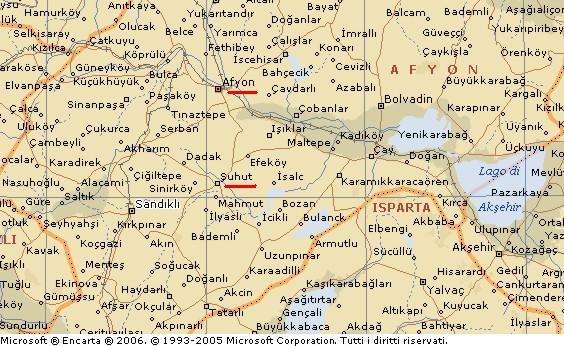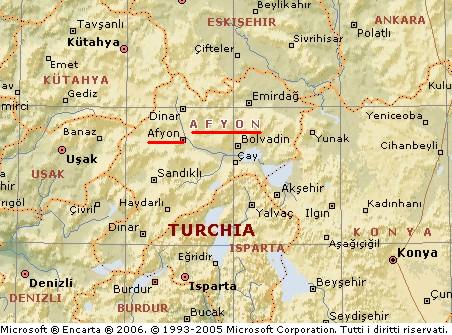Lessico
Sinnada

In
greco per lo pi¨ suona Σύνναδα,
talora Σύναδα, in latino Synnada:
antico capoluogo della Frigia![]() , sul sito dell'attuale
Şuhut
, sul sito dell'attuale
Şuhut![]() , presso Afyon. Diede il
nome ai marmi, sia bianchi che policromi, come il pavonazzetto, estratti nelle
numerose cave ancora visibili nella regione, ampiamente esportati in tutto il
mondo romano e a Roma stessa.
, presso Afyon. Diede il
nome ai marmi, sia bianchi che policromi, come il pavonazzetto, estratti nelle
numerose cave ancora visibili nella regione, ampiamente esportati in tutto il
mondo romano e a Roma stessa.

Synnada (Greek: Σύνναδα) was an ancient town of Phrygia Salutaris in Asia Minor. Its site is now occupied by the modern Turkish town of Şuhut, in Afyonkarahisar Province. Synnada remains a Roman Catholic Titular metropolis. Synnada was situated in the south-eastern part of eastern Phrygia, or Parorea, thus named because it extended to the foot of the mountains of Pisidia, at the extremity of a plain about 60 stadia in length, and covered with olive plantations.
Synnada is said to have been founded by Acamas who went to Phrygia after the Trojan war and took some Macedonian colonists. It enters written history when the Roman consul Gnaeus Manlius Vulso passed through that city on his expeditions against the Galatians (189 BCE). After having belonged to the kingdom of the Attalids, it became the capital of a district of the province of Asia, except on two occasions during the last century of the Roman Republic when it was temporarily attached to Cilicia. Under Diocletian at the time of the creation of Phrygia Pacatiana, Synnada, at the intersection of two great roads, became the metropolis (capital). In Strabo's time it was still a small town, but when Pliny wrote it was an important place, being the conventus juridicus for the whole of the surrounding country. Cicero mentions that he passed through Synnada on his way from Ephesus to Cilicia.
The city was celebrated throughout the Roman Empire on account of the trade in a beautiful kind of marble, which came from nearby quarries and was commonly called Synnadic marble, though it came properly from a place in the neighborhood, Docimia, whence it was more correctly called Docimites lapis. This marble was of a light color, interspersed with purple spots and veins. Under Diocletian at the time of the creation of Phrygia Pacatiana, Synnada, at the intersection of two great roads, became the metropolis (capital). On its coins, which disappear after the reign of Gallienus, its inhabitants call themselves Dorians and Ionians. Under Ottoman rule it became the city of Schifout Kassaba, situated five hours south of Afyonkarahisar, in the vilayet of Broussa.
Christianity was introduced at an early date into Synnada. The Martyrologium Hieronymianum mentions several of its martyrs. For St. Trophimus, honoured by the Latin (Catholic) and Greek (Orthodox) Churches on 19 September. A reliquary in the form of a sarcophagus containing some of the bones of this martyr has been discovered at Schifout Kassaba and transported to the museum at Broussa; this monument may date back to the third century. Eusebius of Caesarea speaks of its pious bishop Atticus who entrusted to the layman Theodore the duty of instructing the Christians. About 230-5 a council on the rebaptizing of heretics was held there. St. Agapetus, mentioned in the Roman Martyrology on 24 March as Bishop of Synnada, belonged to Synaus. For a list of other bishops see Le Quien, Oriens christianus, I, 827. Mention must be made of:
Procopius
(321); Cyriacus, friend of St. John Chrysostom
Theodosius and his competitor Agapetus, at first a Macedonian heretic
Severus (431)
Marinianus (448-51)
Theogenes (536)
Severus (553); St. Pausicacus, during the reign of Emperor Maurice, honoured
by the Greek Church on 13 May
Cosmas, 680
John, adversary of the iconoclasts in the time of Patriarch St. Germanus
St. Michael, honoured by the Latin and Greek churches 23 May, died 23 May,
826, in exile for his zeal in defending the worship of images
Peter under Patriarch Photius
John under Photius
Pantaleon under Leo the Wise
Leo under Basil II
Nicetas in 1082
Georgios at the Council of St. Sophia, about 1450, if one can believe the
apocryphal Acts of this council, which perhaps never occurred.
The last Bishop of Synnada spoken of in the documents, without mentioning his name, probably lived under John Cantacuzenus (see "Cantacuz. Hist.", III, 73) and probably never lived at Synnada on account of the Turkish conquest. Several years after (1385) the see was committed to the Metropolitan of Philadelphia. Finally St. Constantine, a converted Jew of Synnada, lived in the tenth century; he became a monk, and is honoured by the Greek Church 26 December. A famous incumbent of the titular archbishopric was the dissident traditionalist Catholic Archbishop Marcel-Franšois Lefebvre.
Şuhut is a town and district of Afyonkarahisar Province in the Aegean region of Turkey. It lies in a small plain, 25 km south of the city of Afyon. It has an area of 983 km▓, and the population (2000) is 63,127 of which 13,862 live in the town of Şuhut, and the remainder in surrounding villages.
Excavations of a burial mound at Kepirtepe show the plain has been settled since the neolithic period. The town was established during the Hittite period and grew under the Romans, by then it was known as Synnada. Today Şuhut is a country town providing schools and other amenities to the surrounding rural area. Much of the land is used for raising beef cattle and growing wheat, and Şuhut is famed for the quality of its meat and wheat stew, called keşkek. There is also a poultry industry and other crops, such as sugar beet, are grown. The younger generation are migrating to larger cities in search of careers.